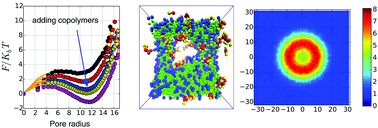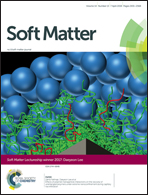Formation and stabilization of pores in bilayer membranes by peptide-like amphiphilic polymers
Abstract
We study pore formation in models of lipid bilayer membranes interacting with amphiphilic copolymers mimicking anti-microbial peptides using Monte Carlo simulations and we rationalize our results by a simple brush-model for the fluid membrane. In our study a weak tension on the membrane is required to observe pore-formation induced by the adsorption of flexible amphiphilic copolymers. The copolymers enhance the pore stability by decreasing the line tension due to weak adsorption along the rim of the pore. Pore formation is enhanced with increasing length of copolymers or stronger stretching of the membrane. Both solvent and copolymer permeability increase as the pore becomes stable. Pore-formation proceeds via a meta-stable pore-state according to a discontinuous phase transition scenario which lead to finite pore-sizes at once. Our generic model of copolymer-induced pore-formation does not require high polymer concentration at the pores nor any self-organization of the copolymers to open the pore.



 Please wait while we load your content...
Please wait while we load your content...